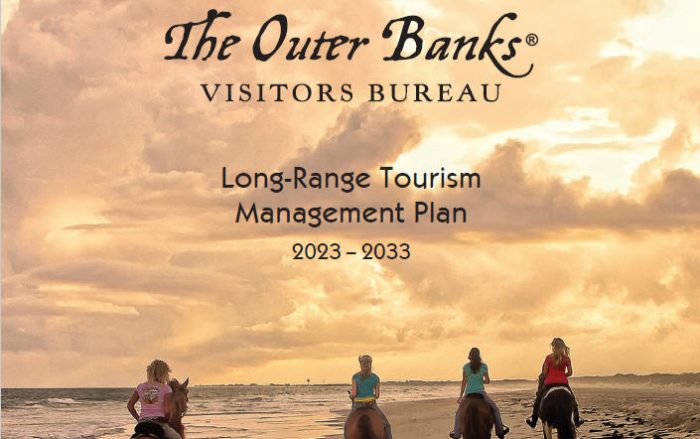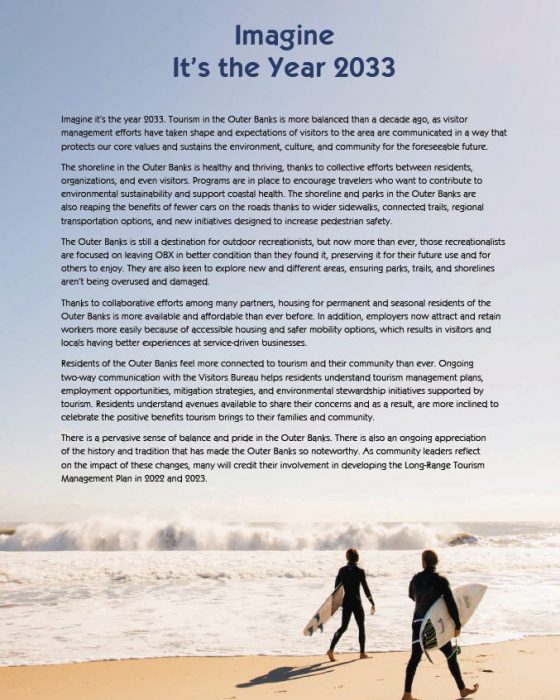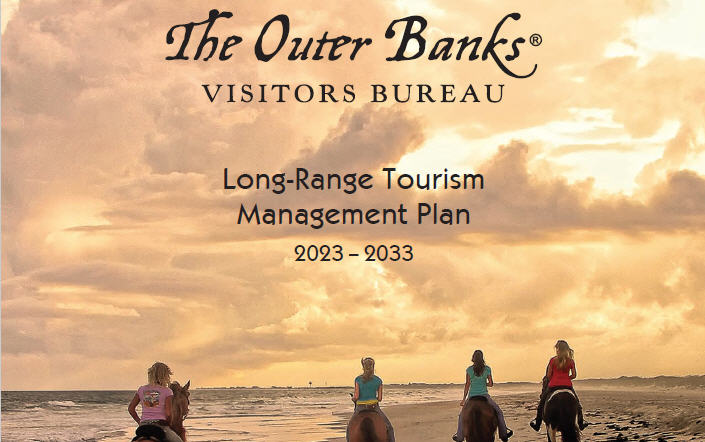
From Wobx.com
Following a nine-month-long process, that included public town hall meetings, a poll of residents, focus groups, a task force composed of representatives from a variety of local agencies and the visitor economy industry, the Outer Banks Visitors Bureau has released the findings of a study that lays out a road map for the future of tourism in the region.
Entitled “Long-Range Tourism Management Plan 2023-2033“, the 65-page report was compiled by MMGY NextFactor, a consulting firm specializing in travel and tourism, for the Dare County Tourism Board and the visitors bureau.
“There weren’t a lot of surprises from the data that we saw,” said Dare County Tourism Board Steering Committee chairman Tim Cafferty.
“The things I see as a business owner, day-to-day came out in spades on this report,” Cafferty said. “What can I do to help and what can others in my role in other places do to help?”

Cafferty is also President of Outer Banks Blue Realty Services, a property/vacation rental management and real estate services company based in Kitty Hawk.
Tourism spending in Dare County topped $1.83 billion last year, the fourth highest county in North Carolina, with one of every three jobs either part of or supported by the visitor economy.
The report was first presented to the tourism board at their monthly meeting on Wednesday, and then later that evening to a gathering of several dozen residents, business owners, and elected and government officials, at the Ramada Plaza in Kill Devil Hills.
“We have a legislative mandate to promote overnight visitation, but there’s nothing that says that we can’t provide something that’s a value and use for the people that live here too,” said Outer Banks Visitors Bureau Executive Director Lee Nettles.
“I think everybody on the tourism board, certainly the visitors bureau, were inspired (by the findings),” Nettles said.
Lee Nettles opens the presentation on The Outer Banks Long Range Tourism Management Plan. [Sam Walker photo]Produced by MMGY NextFactor, a consulting firm specializing in travel and tourism, both presentations on Wednesday were led by MMGY NextFactor Senior Vice President of Destination Stewardship Cassandra McAuley and Executive Consultant Shelly Green.
The pair also led the town hall discussions held in Buxton and Kill Devil Hills in January.
Along with the town halls, more than 4,500 residents responded to an online survey conducted last fall, and detailed interviews were conducted with more than a dozen stakeholders inside and outside the hospitality and tourism industry.
“To mitigate the challenges related to the significant impact of tourism on the Outer Banks, particularly during the peak summer season, the following strategic recommendations will support a balanced growth scenario, ensuring residents and visitors benefit from the visitor economy, with a clear focus on sustainable and manageable visitation,” according to the study’s executive summary.
The report included a crystal ball-like peek at what could be possible one decade from now, based on following the study’s recommendations:

Four strategic goals were identified in the report: strengthen resident and visitor engagement, adopt an integrated approach to improving environmental stewardship, support infrastructure development that supports the vitality of the community residents and visitors, and collaborate to advocate for an increase in residential housing diversity.
The report details ways to boost the resident/visitor relationship, including connecting visitors with non-profits and develop a “volun-tourism” strategy, create resident advisory panels, develop a visitor pledge to “communicate the important values of responsible behavior,” create a task force and hire a Community Engagement Manager to implement the overall plan
On environmental stewardship, the report says the Outer Banks can do more to boost its reputation as a leader in outdoor recreation and caring for its resources, collaborate with environmentally-conscious partners, advocate for roads, sidewalks, and clean mobility to expand options for non-vehicular transportation, create a Sustainability Committee to provide input on minimizing tourism’s impacts on the environment, and investing in data platforms for real-time analytics and use intel for targeting and education.
Infrastructure development recommendations include continuing to advocate for beach nourishment and other shoreline management strategies, commissioning a study of density while developing a capacity management plan, partnering with the Outer Banks Chamber of Commerce on a diverse talent attraction campaign, continue pursuing the Event Center at The Soundside in Nags Head, improve accessibility for all ages and abilities, and support a pedestrian safety plan that factors in a variety of mobility needs.
Finally, the study calls for a more collaborative effort on trying to increase housing opportunities for residents, including working with local government and other partners to advocate for an increase in home ownership options for a wider base of residents, develop ways to educate about needs for more housing diversity, advocate for a balance in short- and long-term rental and home ownership opportunities, increasing public transportation and mobility options and workforce accessibility, and partner with local groups to develop public-private housing development opportunities.
“I think the industry has to step up here and do our part. And whether that’s the sustainability whether it’s the pledge of the visitor, communications, whether it’s voluntourism,” Cafferty said. “These are all exciting things that we’ve never contemplated before.”
“But certainly the housing, transportation, we’ve all got to be a part of the solution,” Cafferty said.
“The good news is visitors love it here,” Nettles said. “And they want to understand the place better, they want to feel like they’re more connected with the Outer Banks and their neighbor. So we just need to give them the tools to help them increase their understanding.”
The report also gave a forecast analysis with potential scenarios of aggressive and moderate growth, and a “retrench” scenario.
The aggressive scenario has the Outer Banks successfully pursuing the key elements of the plan, generating increased visitor spending and economic activity, and in turn bringing in more tax revenue and jobs, and developing a relatively stronger shoulder season which in turn extends seasonal jobs and brings more business into year-round operation.
Under the moderate scenario, key elements of the study are pursued, while managing housing, workforce, and environmental stewardship are prioritized, while a more modest level of visitor spending is sought.
The retrench scenario reflects the pandemic-era growth in visitation’s overall strain on the community, and efforts to manage those challenges from visitor volumes, infrastructure, workforce, and housing garner are not pursued, and results in lower growth in visitor spending and economic activity which leads to lower local tax revenue and fewer jobs.
Nettles said the moderate scenario called for in the report is a more reasonable, and realistic, approach for the Outer Banks as a community.
“One of the other things that comes out of the plan is there’s a lot more than we can do, and should do, to not only concentrate on that sustainable growth, but figure out how to take steps to better align tourism activities with the quality of life for the folks that live here,” Nettles said.
Nettles said the creation of the Residents Advisory Council and hiring the Community Engagement Manager are among the biggest immediate priorities in the short term, and there are a few immediate items that came from the report that will be addressed at next month’s Dare County Tourism Board meeting.
Moving forward from what the reports calls for from Dare County and the six municipalities should not be difficult, Nettles said, and was already expressed during the board’s meeting Wednesday morning.
“Along with representatives from the municipalities, County Commissioner Ervin Bateman said that the plan was a great tool for land use development planning for municipalities and for the county,” Nettles said.
“Every town, every village, has its own unique set of challenges,” Nettles said. “But ideally, there’s enough that we can agree on, and kind of align the efforts moving forward.”
“I’ve been around that board a long time,” Cafferty said. “And it’s the most vibrant organization I’ve been with, that you really come in with a commonality.”
“Someone told me recently the old saying: ‘When’s the best time to plant a tree? 20 years ago. Second best time to plant a tree? Today,” Cafferty said.
“I think that’s what our board feels, ‘We’re not sure where this is going? But we have a great mindset to push this thing along’,” Cafferty said.
- Click to download The Outer Banks Visitors Bureau Long-Range Tourism Management Plan 2023–2033 (.pdf)
- Details about the development of the plan at OuterBanks.org
Posted in Top Stories, Visitor Economy










What a pile of crap and to think tax dollars were used to produce this. Could have saved the money to put towards helping those in need. There was no need to do surveys or study groups as the state of the county tourism industry is obvious to everyone except possibly those who ordered the study. The obvious: (1) Too many people which is incompatible with being pro-environment (2) Not enough housing for residents and summer help which is a result of VRBO and others (3)Effectively priced the traditional family out of their annual vacation. Nothing is going to fix this and attitudes about the environment will never be a consideration by those who bring 8 cars for their 12-bedroom rental house without regard for the amount of resources used or trash generating. I’m fortunate enough to live in the county, not be dependent on the tourist dollar and immune to all of this nonsense. We are on a one-way street to Virginia Beach. It is really unfortunate the visitors of 20 or more years ago are long gone. No sense of entitlement and small footprints.